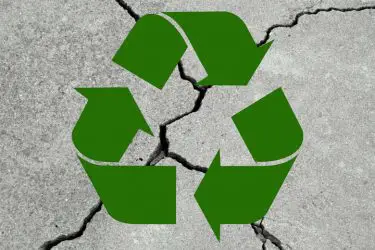Concrete is not something that is typically thought of as an electrical conductor, but it actually is! You, like many other concrete enthusiasts, may be wondering why.
Concrete conducts electricity through the ions it contains. There are several factors that can affect how well concrete conducts electricity and methods by which it’s conductivity can be increased, or decreased, including resistivity and water content.
Let’s go through some of the conditions we know of that influence the conductivity of concrete.

Table of Contents
So What Makes Something Conduct Electricity In The First Place?
It all starts way down at the atomic level. In substances like wood or glass, the atoms are packed super close together and the electrons stick closely to their atoms. Especially when the compounds making up the substance are very stable, this makes it so that the electrons in this substance are unlikely to move, meaning that a greater electrical charge is needed to run through them.
These substances are known as resistors. Electricity will rarely pass through resistors because of the sheer amount of power that it takes to do so.
In contrast, electrical conductors have many free electrons floating around throughout the substance. In the most conductive substances, like copper or gold, there are so many of these free electrons that they form a kind of electron soup, with all of the electrons being shared by all of the atoms. This makes it very easy for electricity to pass through.
So What About Concrete Makes it Conductive?
Concrete is an interesting case. While concrete can become a conductor of electricity, natural concrete is actually much more of a resistor. Dry concrete with nothing but the usual concrete ingredients (sand, water, natural aggregate, etc.) Is a terrible conductor of electricity, and can actually be used as an insulator. In fact, while many substances become more conductive as they heat up, concrete does the opposite, boosting its resistance to ridiculous levels.
During the course of mixing concrete, the very first thing that happens is a sharp decline in resistivity (Source) as water is added to the dry mix to give it its moldability. Then, as the concrete mixes and then dries, resistivity can be observed to decrease, sometimes a hundred-fold. This process is quite unpredictable, with each batch of concrete losing conductivity at a different rate and reaching different heights of resistivity.
This is where the mystery resides. The reason why each batch is different is yet unknown to researchers

Researchers have spent a significant amount of time trying to figure out how to decrease resistivity in concrete. One way in which they have done this is by adding materials that conduct electricity very well, such as various metals. The problem with this is that concrete is a highly alkaline substance, meaning that it will eat away at any metals laid inside of it until they are gone.
Increasing the water content in concrete can also increase it’s conductivity. However, the more water in the concrete mix the weaker it will generally become. Depending on the intended use of the concrete, this can be a serious problem. However, if the concrete only needs to be a little conductive this is often a great solution to the problem of conductivity.
Some companies have also taken to using a kind of carbon-based aggregate to produce electrically conductive concrete. This is one of the more promising conductive concrete technology, but it does have some adverse effects on water absorption.
Additional Factors of Conductivity
The size and shape of an object can also seriously affect conductivity. An object that is very thick will conduct better than a thin object, and a short object will conduct much better than a long one.
Finally, the temperature of an object can seriously pump up the conductivity. Some resistors, like glass, become extremely good conductors when they are very hot. Superconductors do the opposite, conducting electricity extremely well but only at low temperatures.
Good Question. Scientifically altered concrete aside, concrete doesn’t have a lot of conductivity on it’s own. However, there are a couple of situations that occur often in construction that can make run of the mill insulating concrete much more electrically conductive.
One common way that concrete can become conductive is when it has been placed in a wet environment. Concrete is good at absorbing water, and as mentioned above concrete is more conductive when it has higher water content. This means that if it’s been placed inside of wet soil or in a rainy environment, as long as it stays wet, it will be able to the conductor of electricity.
The other situation in which concrete becomes conductive is when it has been cast around steel rebar. Nearly all non-trivial concrete structures include some form of rebar, and the presence of metals in the concrete can make it a fairly strong conductor. This is likely because steel itself is a capable conductor, and so electricity is able to use that steel as a kind of highway through the concrete.
Because of these two very common situations, most concrete used in many building projects is at least a little bit conductive, even if it isn’t that way naturally.
Why Would Anyone Want Their Concrete To Be Conductive?
Conductive concrete has a lot of valuable uses. For one thing, concrete that conducts electricity very well can be used to heat roads and make them safer to use in the snow. I actually used to live in a very snowy part of Japan where this was done. As long as there wasn’t too much snow, they rarely even needed snow plows to clear out the roads! This same technology can even be repurposed to provide radiant heating for homes in cold places.

Another valuable use of conductive concrete is as grounding for lightning rods. Lightning rods need to have a conductive counterpart on the ground to redirect the lightning they catch, and in many places the soil isn’t always very conductive. In those cases, a building’s concrete foundation can often serve as ground for it’s lightning rod, protecting the people living inside.
It’s important to remember that even if the concrete you come into contact with every day might seem like it shouldn’t conduct electricity, it still might. Even if you know that it’s natural cement, you should never count on concrete to keep you safe from live electricity. Unless that electricity is lightning and you are safely inside your home. In that case, concrete might be about to save your life.



